This article aims to serve as a helpful travel guide for Bac Ninh, offering valuable information on various aspects such as weather, transportation, accommodation, food, and more. Whether you’re planning a visit or simply interested in learning more about this destination, the following guide will provide you with the necessary details to enhance your experience.
General Information
Bac Ninh, located around 40 kilometers from Hanoi, once a prominent trading hub in Vietnam from the 2nd to the 10th century, holds a significant place in history. It serves as the birthplace of Buddhism in the region, with the religion taking root early on and flourishing during the Ly Dynasty. Exploring this area, visitors are captivated by a collection of ancient pagodas and temples that embody the rich cultural heritage and architectural style of Buddhism. Among the noteworthy sites are Keo Pagoda, Dau Pagoda, But Thap Pagoda, Phat Tich Pagoda, and Do Temple. These revered landmarks stand as tangible representations of cultural value, cherished and passed down through generations. The local people of Bac Ninh take immense pride in this heritage and are dedicated to its preservation.
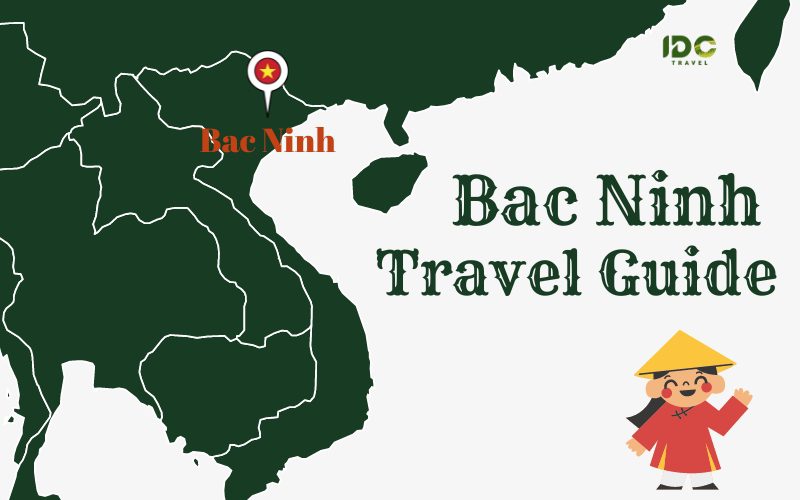
Bac Ninh Location
In addition to its tangible cultural treasures, Bac Ninh boasts a wealth of intangible heritage, particularly in the form of vibrant festivals held predominantly during spring at various pagodas and temples. Among these, Bac Ninh is renowned among foreign visitors as the birthplace of a traditional folk song known as “Quan Ho.” This captivating art form takes center stage at the annual Lim Festival, held on the 13th day of the first lunar month. For international tourists, the opportunity to partake in this celebration and listen to the enchanting melodies of “Quan Ho” leaves an indelible impression that lingers in their memories.
Weather and Best Time to Visit Bac Ninh
Like other regions of Northern Vietnam, Bac Ninh has four seasons:
- Spring (From February to April)
- Summer (From May to August)
- Autumn (From September to October)
- Winter (From November to January).
Bac Ninh experiences delightful weather during the spring, characterized by a pleasant balance between coolness and warmth. As for the summer season, it brings the highest temperatures of the year, occasionally soaring to 39 degrees Celsius. Additionally, this period coincides with the rainy season in Northern Vietnam, resulting in frequent heavy rainfall, particularly in the afternoon and evening. These downpours have the potential to disrupt sightseeing tours, but fret not, as there are numerous indoor activities available to enjoy in Bac Ninh even on rainy days.
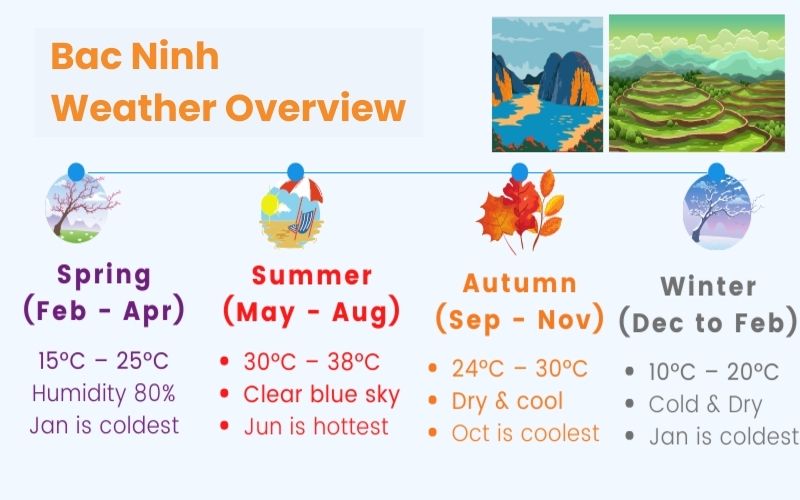
The weather in Bac Ninh
The Lim Festival, Dau Pagoda Festival, and Do Temple Festival are held during the cooler months spanning from January to March. However, the ideal time to explore Bac Ninh’s natural wonders and craft villages is during the summer and autumn seasons. During this period, the region showcases its vibrant beauty. Furthermore, in December, photographers are particularly drawn to the magnificent blooming fields of canola flowers along the Duong River, offering a captivating sight to behold.
Getting to Bac Ninh
Situated approximately 40 kilometers away from Hanoi, Bac Ninh is a conveniently reachable destination that can be reached within an hour. With its close proximity to the capital city, it serves as an ideal location for cultural tourism activities during the weekends.
By plane
If you are coming from a distant location or abroad, the most convenient way to reach Bac Ninh is by flying to Hanoi’s Noi Bai International Airport, which is the closest major airport. Once you arrive at Noi Bai International Airport, you’ll have several transportation options to get to Bac Ninh, including taxis, private transfers, or public transportation.
By train
Bac Ninh has a reliable railway network, allowing you to conveniently travel to Bac Ninh Railway Station from various cities across Vietnam. Hanoi serves as a popular departure point with frequent train services available. Upon reaching Bac Ninh Railway Station, you can easily continue your journey by taking a taxi or local transportation to your desired destination within Bac Ninh.
By bus
There are regular bus services connecting Bac Ninh with various cities in Vietnam. Buses depart from major bus terminals or stations, with Hanoi being a prominent hub offering frequent connections to Bac Ninh. It is recommended to check the bus schedules and consider booking tickets in advance to ensure a smooth journey.
By taxi/private car
For those who prefer driving, Bac Ninh can be reached by car or by hiring a taxi from Hanoi or neighboring cities. The travel distance and time will vary depending on your starting point and the specific route you choose. Major highways such as National Highway 1 or Phap Van – Cau Gie Expressway provide convenient connections between Hanoi and Bac Ninh. These well-maintained roads ensure a smooth and efficient journey.
For optimal time management and increased flexibility during your visit, you also have the opportunity to rent a car with a private driver. This option grants you the advantage of proactive pick-up and drop-off arrangements, ensuring a convenient schedule as you explore the center of Bac Ninh and its nearby regions. With this service, you can make the most of your time and have the flexibility to fully experience all that Bac Ninh has to offer.
Accommodation in Bac Ninh
In Bac Ninh, a wide range of accommodations is available, catering to different budgets and preferences.
If you’re traveling with a large group of friends or family, there are excellent homestay options like My Retreat – Hien Van, Jungle House Bac Ninh, and Zen Villa. These accommodations can comfortably accommodate four to eight people, with prices ranging from VND2,000,000 to 3,000,000 (US$84.98 to 127.50) per night.
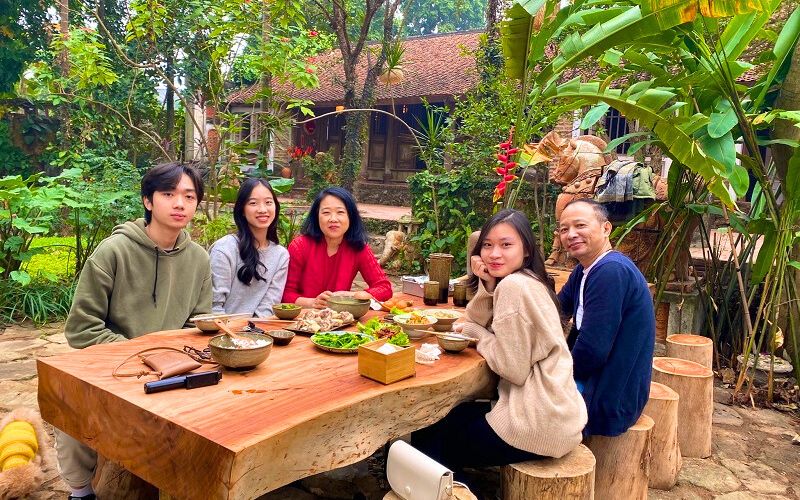
My Retreat – Hien Van
If you’re looking for more budget-friendly options, consider Hana Apartment & Hotel, Asia Apartment Hotel Bac Ninh, or Xuan Hoa Motel. These locations provide affordable rates, typically ranging from VND300,000 to 450,000 (US$12.74 to 19.12) per night. For those seeking a more private and luxurious experience, hotels such as Le Indochina Hotel, Muong Thanh Luxury Bac Ninh, and Mandala Hotel & Spa are great choices. These hotels offer a range of amenities and can be booked for approximately VND1,000,000 to 1,600,000 ($42.54 to 68.07) per night.
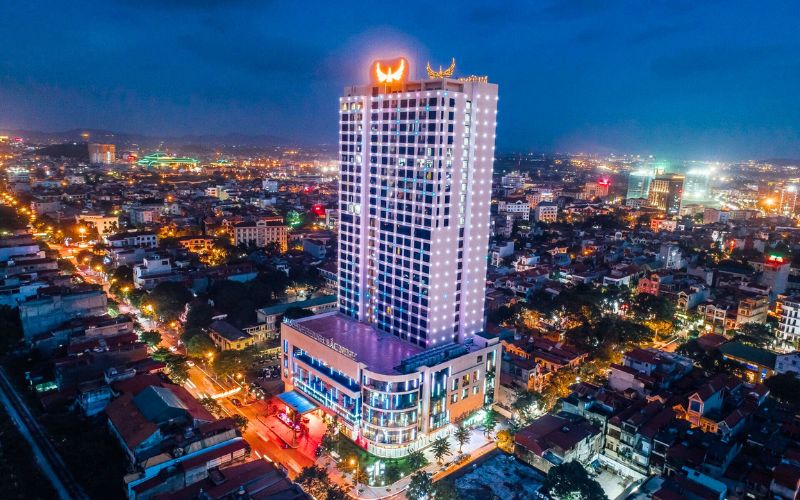
Muong Thanh Luxury Bac Ninh
Unique Highlights of Bac Ninh
Lim Festival
The Lim Festival is a renowned cultural event held annually in Vietnam. It takes place during the 13th to 15th days of the first lunar month. This festival is known for its lively atmosphere and diverse array of activities.
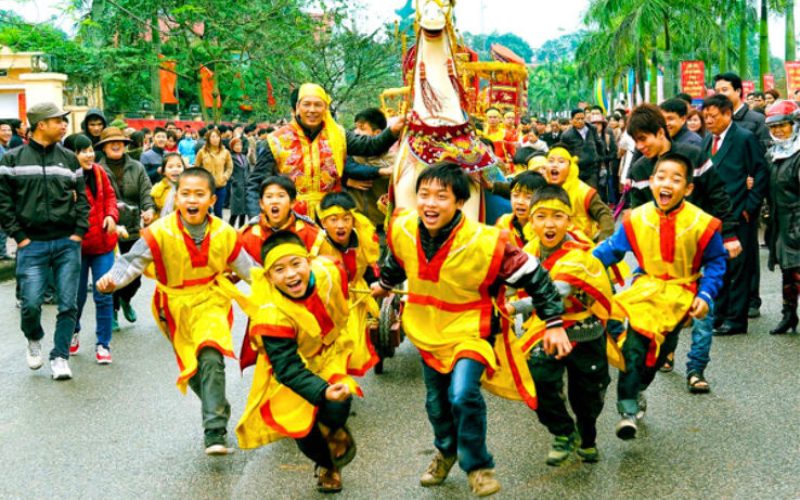
Lim Festival
One of the main highlights of the Lim Festival is the traditional games that are organized, including wrestling, pot breaking, tug of war, and a captivating human chess competition. These games not only entertain the spectators but also showcase the skill and strength of the participants. However, the most prominent feature of the Lim Festival is the Quan ho singing competitions. Quan ho is a form of Vietnamese folk music that involves captivating duets performed by local singers. These melodious and harmonious songs are an integral part of the festival and represent the rich cultural heritage of the region.
Attending the Lim Festival provides you with the opportunity to immerse yourself in the traditions and customs of Vietnam. It is a time of celebration, cultural exchange, and enjoyment, drawing tourists and locals alike to partake in the festivities and experience the beauty of Vietnamese culture firsthand.
Do Temple Festival
The Do Temple Festival takes place during the third lunar month, although visitors from all over the world are welcome to explore it at any time throughout the year. The festival, held in Dinh Bang village, pays tribute to King Ly Cong Uan (Ly Thai To), the esteemed founder of the Ly Dynasty (1009-1225). Its primary purpose is to express gratitude and honor those who have contributed to the nation’s well-being, particularly the Ly kings, while also seeking peace and happiness.

Do Temple Festival
During the festival, procession ceremonies are conducted to honor Queen Dowager Pham Thi, the mother of King Ly Thai To, and the eight other Ly Kings. A mesmerizing dragon dance is performed, symbolizing wishes for the prosperity and well-being of the local community. Traditional sports like wrestling, human chess, and cockfighting engage the participation of locals, while rice cooking competitions, calligraphy displays, and enchanting quan ho singing add to the vibrant atmosphere.
Dan Ca Quan Ho (Quan Ho Folk Songs)
In September 2009, UNESCO recognized Quan Ho Bac Ninh as an Intangible Cultural Heritage of Humanity. The origins of Quan Ho singing can be traced back centuries ago to 49 quan ho villages in and around Bac Ninh. This unique art form combines poetry, song, and a distinctive lyrical call-and-response performance. In some localities, including those in neighboring Bac Giang Province, a variation of Quan Ho takes place on a lake, where couples sing duets to each other from different boats.
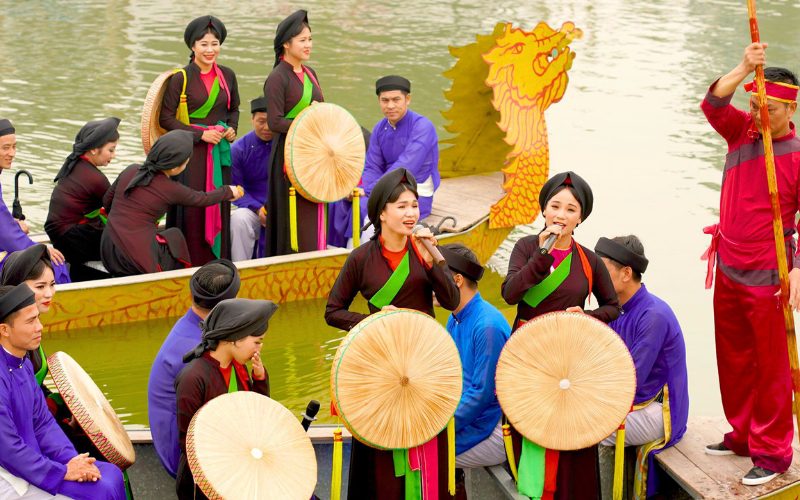
Quan Ho Bac Ninh
Quan Ho singing is not limited to specific occasions; it is frequently performed during New Year festivals and can be enjoyed at various special events. The art form has become an integral part of the cultural fabric of Bac Ninh, providing a captivating and expressive means of communication through music and lyrical exchanges.
Best Places to Visit in Bac Ninh
Dinh Bang Communal House
The Dinh Bang Communal House stands as a remarkable testament to ancient architecture, showcasing its intricate wooden craftsmanship. For centuries, the local Vietnamese community has gathered here to worship the Mountain Spirit Cao Son Dai Vuong and the Water Spirit Thuy Ba Dai Vuong, revered figures who brought prosperity and peace to the land. Unfortunately, the historic communal house fell victim to destruction by Ming invaders during the 1400s. However, in a display of resilience, five determined locals swiftly rebuilt the structure after the Ming were expelled from Vietnam. Dinh Bang is situated within the captivating historical complex that houses the renowned Do Temple. Exploring this area will transport you back in time, immersing you in the ambiance of a bygone era that spans hundreds of years.
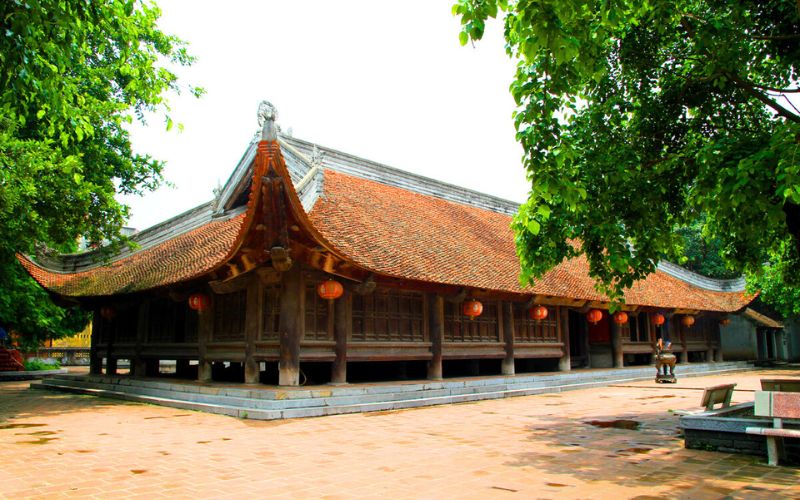
Dinh Bang Communal House
Do Temple
Do Temple is situated in Dinh Bang Village, Tu Son District. The temple has a rich history dating back over a thousand years. It was built to honor and worship the eight kings of the Ly Dynasty, particularly the Ly Thai To, who founded the dynasty and moved the capital to Thang Long (present-day Hanoi).
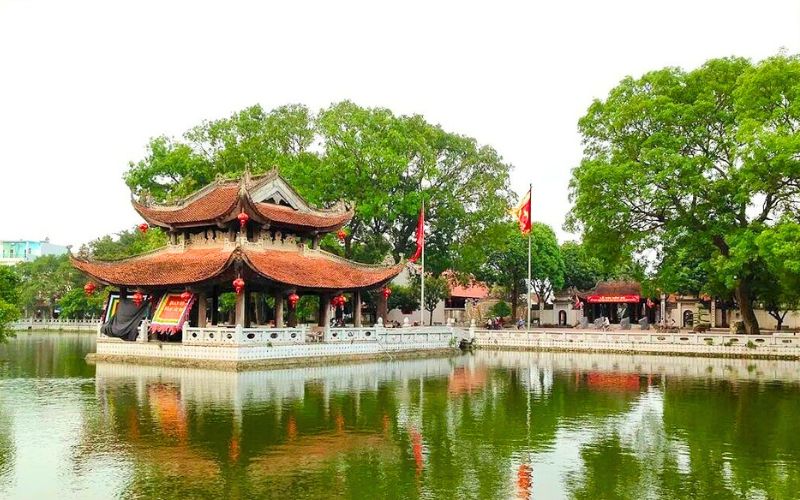
Do Temple
Do Temple showcases traditional Vietnamese architectural styles. The complex consists of several structures, including the main entrance gate, courtyards, altars, and ceremonial halls. The buildings have intricate carvings, detailed decorations, and vibrant colors. The temple hosts various annual festivals, with the most significant being the Do Temple Festival, which takes place from the 14th to the 16th day of the third lunar month. During the festival, visitors can witness traditional rituals, enjoy cultural performances, and participate in exciting activities.
Kinh Duong Vuong Tomb
The Kinh Duong Vuong Tomb is an important historical site located in Bac Ninh, Vietnam. It is a revered place associated with Kinh Duong Vuong, the legendary figure believed to be the founder of the first Vietnamese nation, known as the Van Lang Kingdom. The tomb is situated in a tranquil and picturesque setting, surrounded by lush greenery and serene landscapes. It serves as a significant cultural and historical landmark, attracting visitors who are interested in exploring the ancient origins of Vietnamese civilization. Visiting the Kinh Duong Vuong Tomb allows you to delve into the legends and myths surrounding the figure of Kinh Duong Vuong.
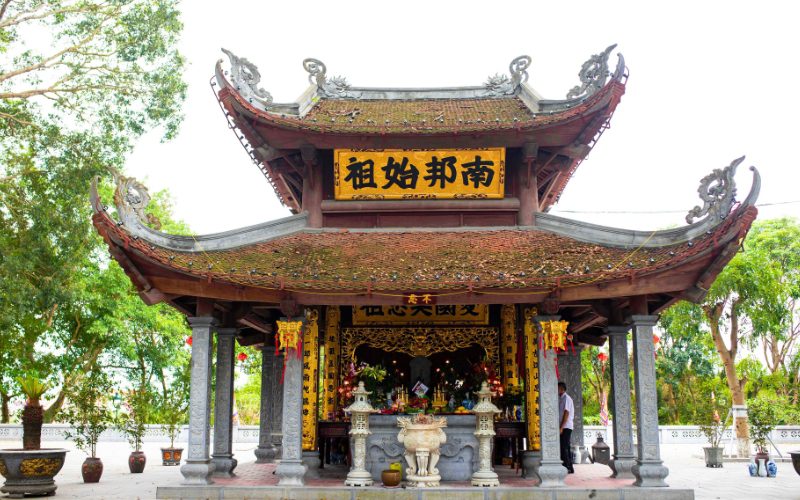
Kinh Duong Vuong Tomb
Tieu Pagoda
Tieu Pagoda played a prominent role as a Buddhist center during the Ly Dynasty, serving as a place of worship for the Three Jewels of Buddhism: the Buddha (the enlightened one), the dharma (the teachings), and the sangha (the community of practitioners). Additionally, the pagoda encompasses an ancestral house dedicated to honoring and worshiping ancestors.
Despite undergoing numerous restoration efforts, the pagoda has successfully maintained several original architectural elements from the Ly Dynasty, as well as subsequent periods such as the Le Dynasty (1740–1786) and Nguyen Dynasty (1802–1945). Within its sacred grounds, Tieu Pagoda safeguards an impressive collection of rare artifacts and historical records that chronicle the evolution of Vietnamese Buddhism. Among these treasures are ancient documents shedding light on the life and reign of King Ly Thai To, one of the founding figures in the establishment of modern Vietnam.
Dau Pagoda
The construction of Dau Pagoda commenced in 187 and was completed in 226, near the Luy Lau citadel. This sacred site attracts many visitors, not just for its serene ambiance and the opportunity to pray for global harmony, but also for its remarkable architectural features, notably the Hoa Phong Tower situated at its heart. During the reign of King Tran Anh Tong in 1313, the pagoda underwent restoration under the guidance of Confucian scholar Mac Dinh Chi, who also oversaw the construction of the tower. Within the tower, a set of bronze bells was installed, with each bell meticulously cast in the years 1793 and 1817, adding to the pagoda’s cultural and historical significance.
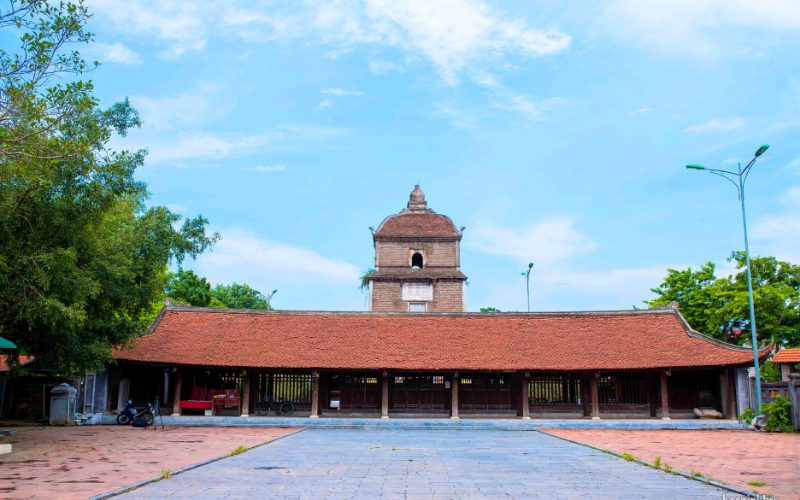
Dau Pagoda
But Thap Pagoda
But Thap Pagoda, also known as Ninh Phuc Tu, stands as a symbol of spiritual and architectural beauty, attracting visitors from near and far to visit Bac Ninh. Dating back to the 13th century, But Thap Pagoda holds a significant place in Vietnamese history and culture. The name “But Thap” translates to “pen tower,” derived from the distinctive tower within the pagoda complex that resembles a traditional writing brush.
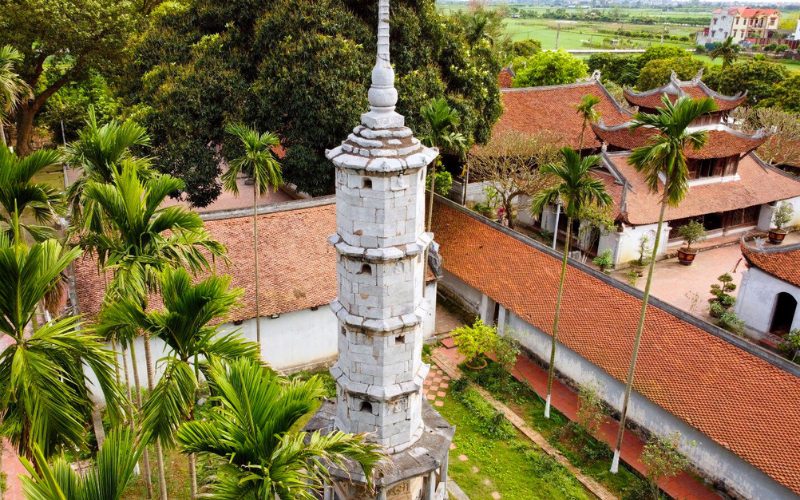
But Thap Pagoda
The pagoda features stunning architecture characterized by intricate wood carvings, exquisite stone sculptures, and ornate decorations. The main hall houses an impressive statue of Avalokitesvara Bodhisattva, a revered Buddhist deity. The pagoda is also home to a rich collection of Buddhist scriptures, ancient bells, and valuable cultural relics. Surrounding the pagoda are tranquil gardens and beautiful lotus ponds, adding to the serene and peaceful ambiance of the site.
Phat Tich Pagoda
Located on Lan Kha Mountain, Phat Tich Pagoda shines as an ancient treasure. Its sacred grounds are protected by ten extraordinary kneeling animal statues dating back to the 11th century, crafted by artisans during the illustrious Ly Dynasty. These sandstone sculptures are unique and irreplaceable, representing a remarkable testament to the artistry of their time. Positioned at the entrance of the temple, the Three Jewels Gate, stand stone guardian beasts including lions, elephants, buffalo, rhinoceroses, and horses, carefully arranged in pairs. These awe-inspiring creatures serve as symbolic protectors, creating a harmonious and sacred atmosphere for visitors and devotees alike.

Phat Tich Pagoda
Cung Temple – Ngoc Well
Nestled within Diem village of Bac Ninh City, Cung Temple holds great renown for its local legend of defending Vietnam against foreign invaders. According to the tale, the imperial army sought solace and divine intervention at this sacred site during their battles along the Cau River, ultimately leading to a victorious outcome.
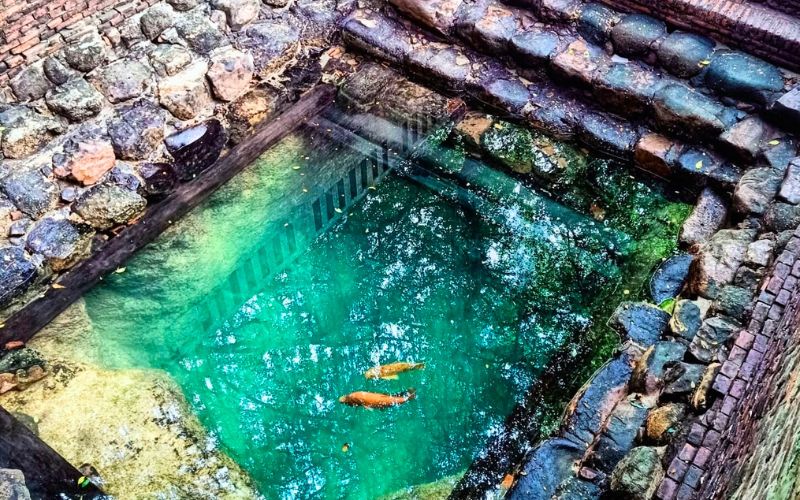
Ngoc Well – the most significant feature of Cung Temple
At the heart of the courtyard, Ngoc Well is the most significant feature of Cung Temple. Visitors frequently gather water from this well, particularly on hot days, to refresh themselves after exploring the temple and making offerings. To access the water, visitors respectfully leave their shoes and sandals on the shore and walk barefoot toward the well. The water from Ngoc Well possesses a refreshing and natural sweetness, allowing visitors to drink it directly without the need for filtration or boiling.
Ba Chua Kho Temple
The “Lady of the Storehouse” or “Ba Chua Kho” is a traditional folk tale and legend associated with Bac Ninh, a province in Vietnam. According to the legend, there was once a kind-hearted and generous woman who served as the caretaker of a storehouse. She would provide rice and other essential supplies to those in need, especially during times of famine or hardship. The Lady of the Storehouse became renowned for her compassion and selflessness, and her story has been passed down through generations as a symbol of generosity and community spirit. She represents the noble values of sharing and helping others, and her legacy continues to inspire people in Bac Ninh and beyond.
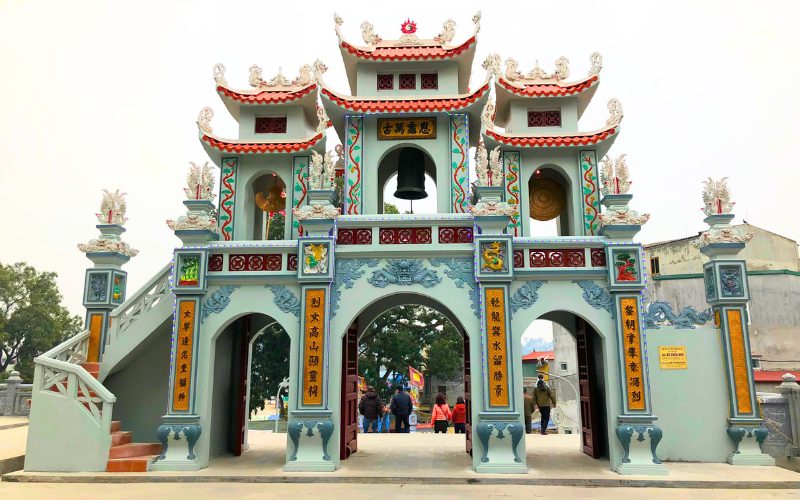
Ba Chua Kho Temple
Phu Lang Pottery Village
Located in the Que Vo District, Phu Lang Pottery Village holds the prestigious designation of being recognized as a National Intangible Cultural Heritage in 2016. As you stroll along the streets of Phu Lang, you’ll be captivated by the vibrant display of ceramic creations adorning the surroundings. This renowned pottery village produces an array of ceramic products, ranging from household essentials like pots and jars to exquisite pieces used for interior and exterior decoration.
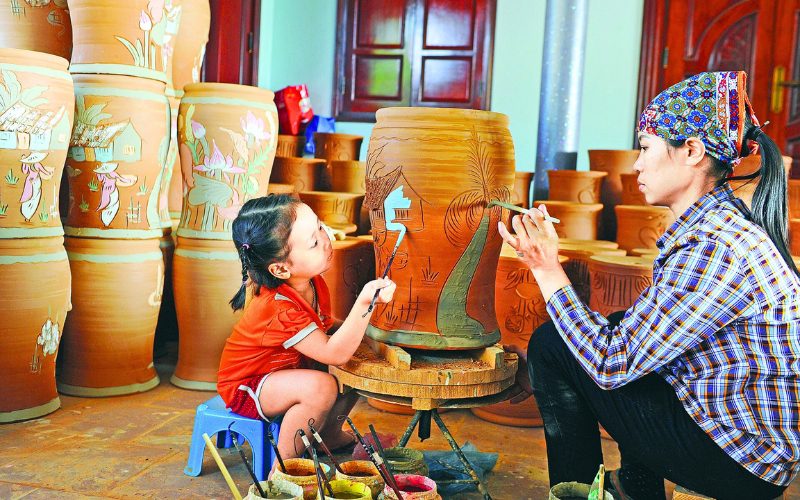
Phu Lang Pottery Village
The distinctive charm of Phu Lang pottery lies in its earthy tones of brown, black, and light yellow. Each meticulously crafted piece undergoes a series of meticulous stages, including shaping, mold cutting, drying, and firing. Notably, Phu Lang pottery excels in the art of carving-based embodiment techniques, which infuse the final product with a natural, enduring, and truly unique appearance. Exploring Phu Lang Pottery Village allows you to witness firsthand the rich heritage and exceptional skills of the local artisans who have mastered the art of Phu Lang pottery generation after generation.
Dong Ho Painting Village
Situated along the banks of the Duong River in Thuan Thanh District, Dong Ho village is known for its distinctive art form showcasing the nation’s cultural heritage. The renowned paintings of Dong Ho village are not traditionally painted, but instead created through the intricate process of printing using molds. Achieving a high level of artistic excellence requires the expertise of skilled painters who possess strong drawing abilities.
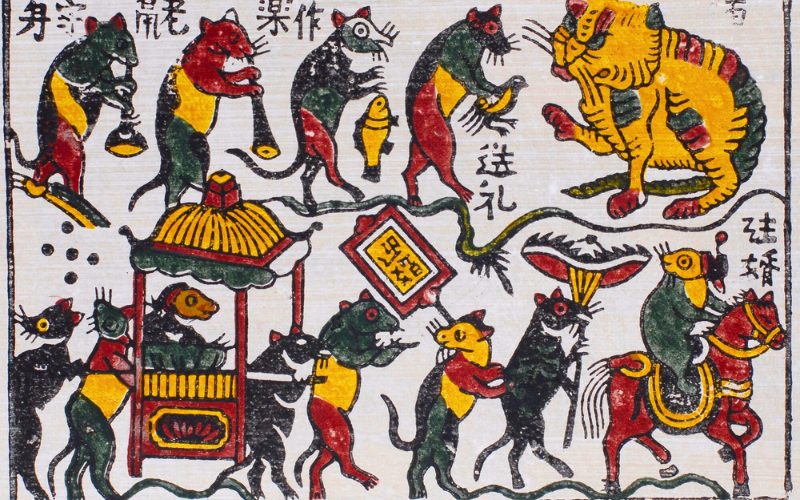
Dong Ho Painting Village
The paper utilized for printing these remarkable pictures is known as “diep paper“. It is meticulously crafted from the inner bark of the “do tree”, which is then combined with powdered scallop shells to create the base material called “do paper.” When the vivid colors and intricate images are printed onto this special paper, they come together in perfect harmony. Dong Ho village’s unique art form, with its printed paintings on diep paper, offers visitors a depth insight into the cultural identity and artistic talent of the region.
Viem Xa Village
Viem Xa Village has situated in the Yen Phong District of Bac Ninh Province. The village has a long history that dates back over a thousand years. One of the notable features of Viem Xa Village is its traditional architecture, which reflects the typical Vietnamese village style. The village is characterized by its well-preserved ancient houses, communal houses, and temples. These structures are built using traditional materials like wood, bamboo, and clay, showcasing the skill and craftsmanship of the local artisans.
The village is also known for its cultural heritage and traditional crafts. It has been famous for producing bronze drums, which are considered one of the most significant symbols of Vietnamese culture. The bronze drums from Viem Xa Village are highly valued for their craftsmanship and artistic designs. The village also hosts cultural festivals and events that showcase traditional music, dance, and cuisine.
Luy Lau Ancient Citadel
Dating back to the 3rd century, the Luy Lau Ancient Citadel stands as a testament to the rich cultural heritage and architectural achievements of the region. The citadel was built during the reign of King Tu Duc, a prominent ruler of the early Vietnamese dynasties. It played a crucial role in protecting the region and facilitating governance during that time. The destination comprises various structures, including walls, gates, watchtowers, and palaces. These architectural elements showcase the skilled craftsmanship and architectural prowess of the era. The citadel’s design reflects a combination of indigenous Vietnamese and Chinese architectural influences, making it a unique historical and cultural treasure.
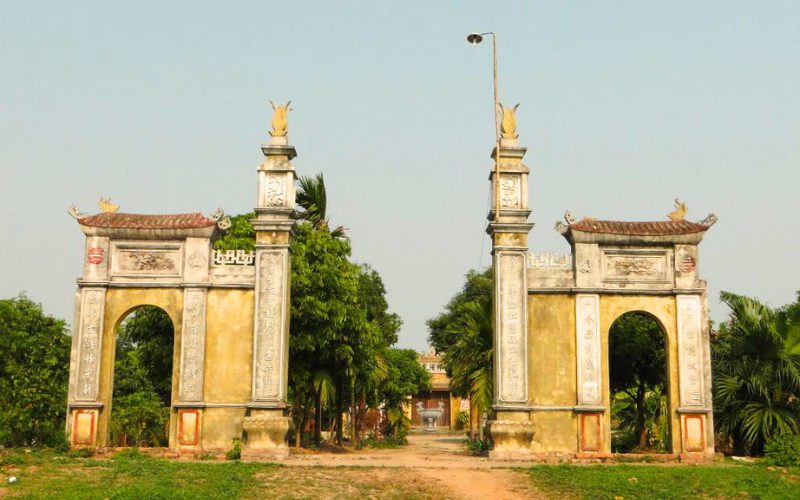
Luy Lau Ancient Citadel
Must-try Foods in Bac Ninh
Phu The Cake of Dinh Bang
The Dinh Bang Phu The cake, also known as the conjugal cake, holds a special place in Bac Ninh’s culinary tradition. This delightful delicacy is prepared by boiling a mixture wrapped in dong leaves, the same ones used for the traditional Tet square cakes called Banh Chung. To craft this delectable treat, the cook skillfully combines steamed and mashed green beans with white sugar, copra, lotus seeds, and a blend of five spices. The cake flour is meticulously derived from glutinous rice, which is milled, filtered to extract its essence, squeezed, and finally dried. When all these ingredients harmoniously blend together, they create an unforgettable symphony of flavors.
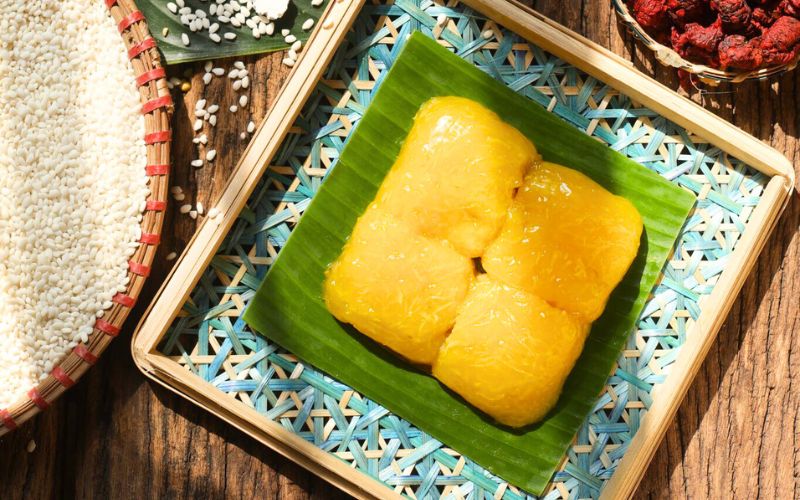
Dinh Bang’s Phu The Cake
Banh Te (Rice Cake)
Banh Te, a rice cake specialty hailing from Cho village in Yen Phong District, is renowned for its unique flavors. The locals of Cho village prefer using plain rice, which possesses a pleasant aroma and a moderate softness, as the key ingredient for crafting this delightful cake. The filling consists of succulent pork rump or shoulder meat, wood ear mushrooms, crispy fried shallots, well-balanced seasoning, fish sauce, and a touch of pepper. Served steaming hot, the cake reaches its pinnacle of taste. The enticing fragrance emitted by the cake, combined with the alluring scent of dong leaves, entices diners to indulge.
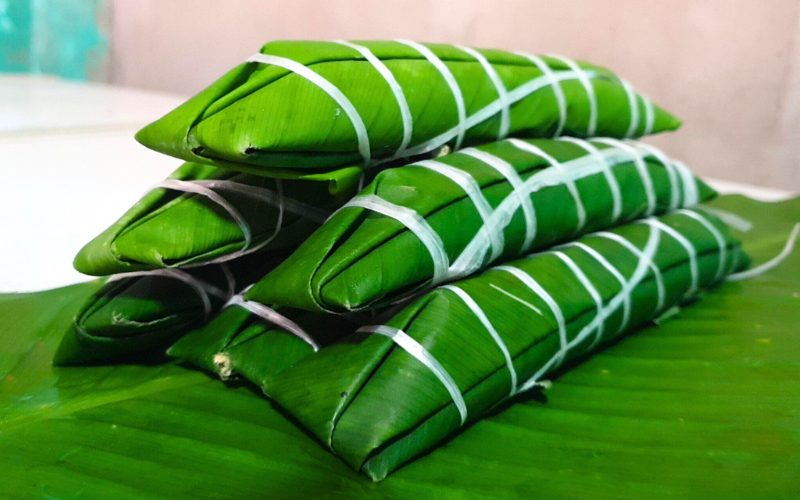
Te Cake
Nem Bui (Fermented Pork)
When exploring Bac Ninh, it’s essential for travelers to savor the renowned nem bui, a delectable fermented pork dish that should not be missed. Originating from Bui village, located in Ninh Xa Commune, Thuan Thanh District, this culinary gem has gained popularity in recent years, renowned for its deliciousness. The locals also refer to it as nem thinh, as thinh, or ground roasted rice, which plays a vital role in its preparation. Depending on personal preferences, the fermented pork can be wrapped in fig leaves and enjoyed with either chili sauce or fish sauce for dipping. The sharpness of the fig leaves, the sweetness of the succulent meat, and the enticing aroma of the roasted rice powder harmonize beautifully.
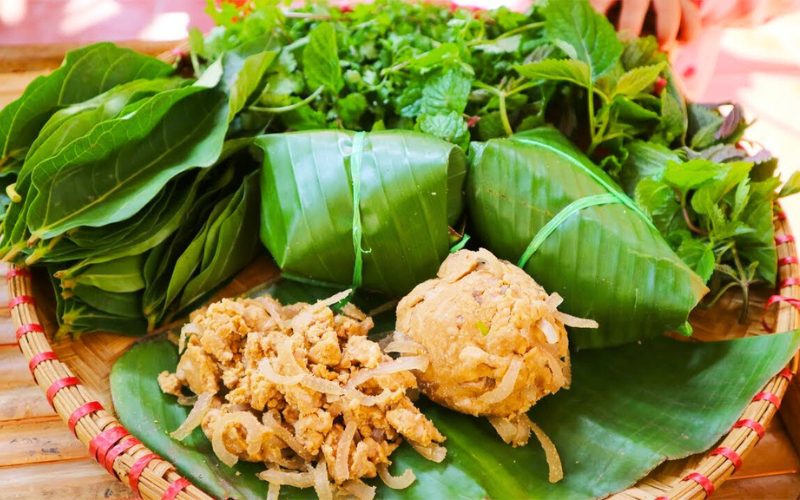
Nem Bui (Fermented Pork)
Banh Khuc of Diem Village (Sticky Rice Balls)
Banh Khuc, the delightful sticky rice balls, hold a special significance during Tet holidays, summer festivals, full moons, or the beginning of each lunar month, as they serve as an invitation to welcome relatives and guests. To create these treats, the residents of Diem village carefully select cudweed leaves, which flourish along vacant lots, alluvial lands near rivers, and fields. Whenever visitors arrive, the inhabitants of Diem village swiftly commence the preparation of banh khuc, as its creation requires minimal time and effort. These unique rice balls boast a flavor that is truly unparalleled, making them a rare find elsewhere.
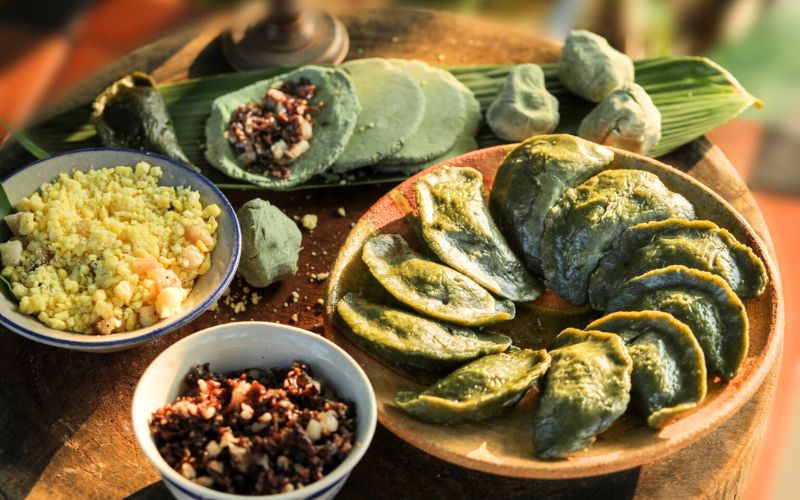
Banh Khuc of Diem Village
Steamed Rice Rolls of Mao Dien
Mao Dien steamed rice rolls, also known as Banh Cuon Mao Dien, are a popular delicacy hailing from Mao Dien village. This dish has gained recognition for its unique preparation method and delectable flavors. This delicious dish is made by pouring a thin layer of rice batter onto a cloth stretched over a pot of boiling water. The steam cooks the rice batter, resulting in thin and delicate rice sheets. These sheets are then carefully rolled with a savory filling, typically consisting of minced pork, wood ear mushrooms, and fragrant herbs. The combination of the smooth rice sheets with the flavorful filling creates a harmonious blend of textures and tastes. The rolls are often served with a side of dipping sauce made from fish sauce, vinegar, sugar, and garlic, which adds a tangy element to each bite.
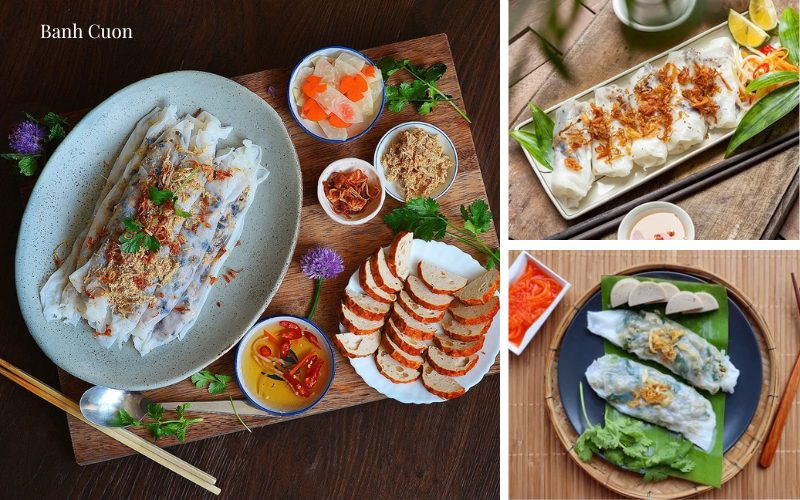
Banh Cuon
Wine of Van Village
The wine of Van Village holds a renowned status for its exceptional quality and rich history. Van Village, known for its winemaking traditions, produces a variety of wines that are highly regarded among enthusiasts and connoisseurs. The winemaking process in Van Village is meticulous and refined, ensuring the production of exquisite wines. Skilled craftsmen carefully select the finest grapes, paying close attention to factors such as ripeness and flavor profiles. These grapes are then skillfully fermented using traditional techniques passed down through generations. Whether enjoyed on its own or paired with fine cuisine, the wine of Van Village offers a delightful sensory experience that captivates wine enthusiasts and leaves a lasting impression.
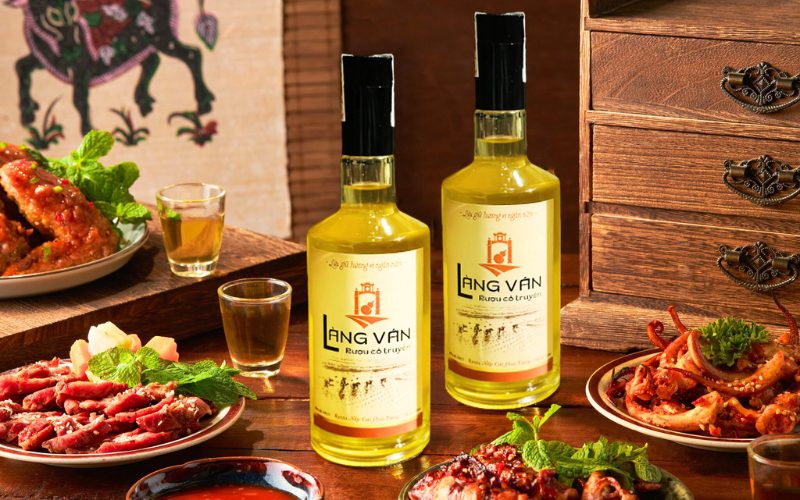
Wine of Van Village
We trust that the information provided in the “Bac Ninh travel guide” article will be of great assistance to you. If you require additional information or seek ideas to create an unforgettable itinerary in Vietnam, please feel free to contact us. We are here to help and ensure your journey is a remarkable one.